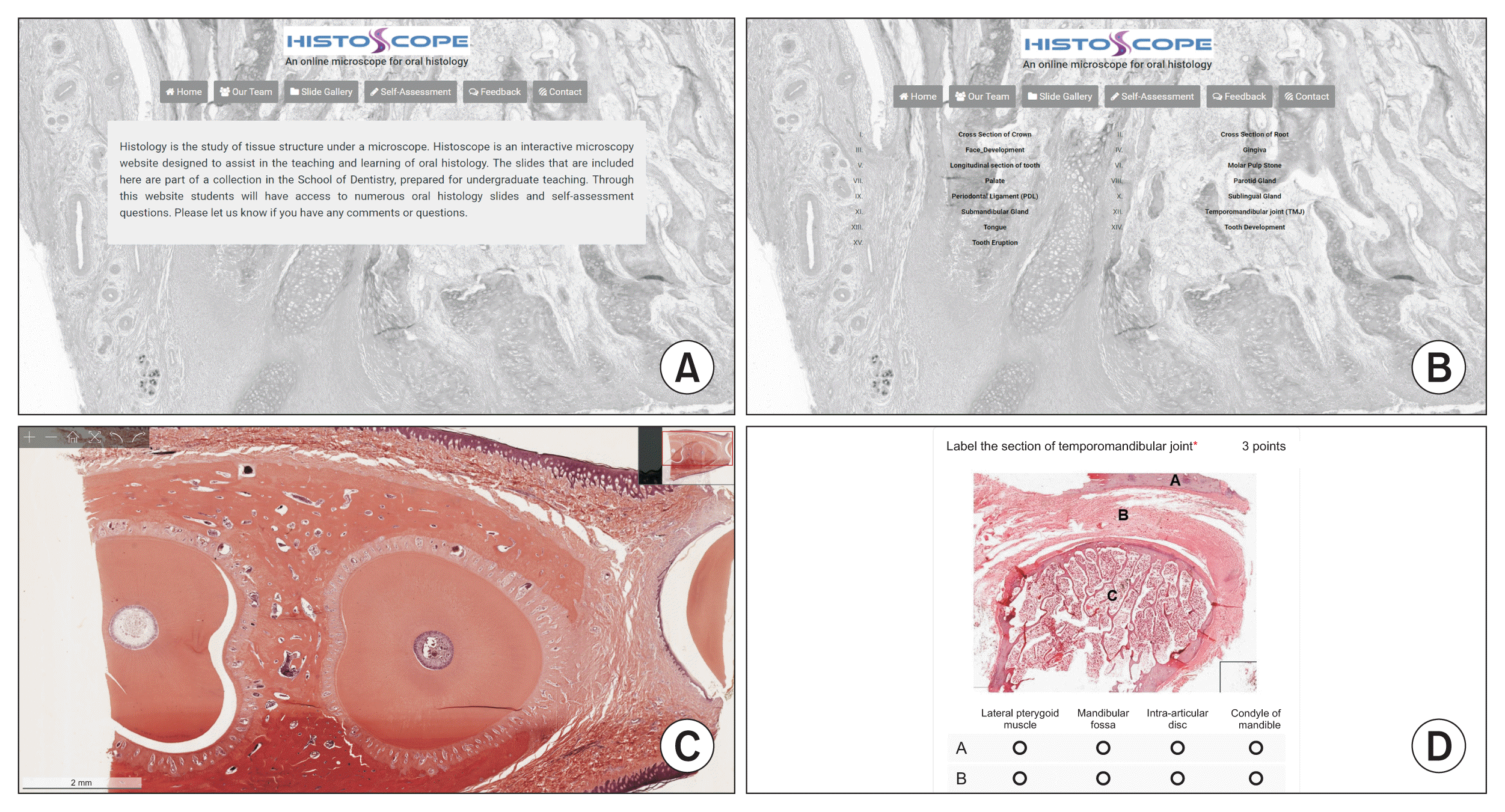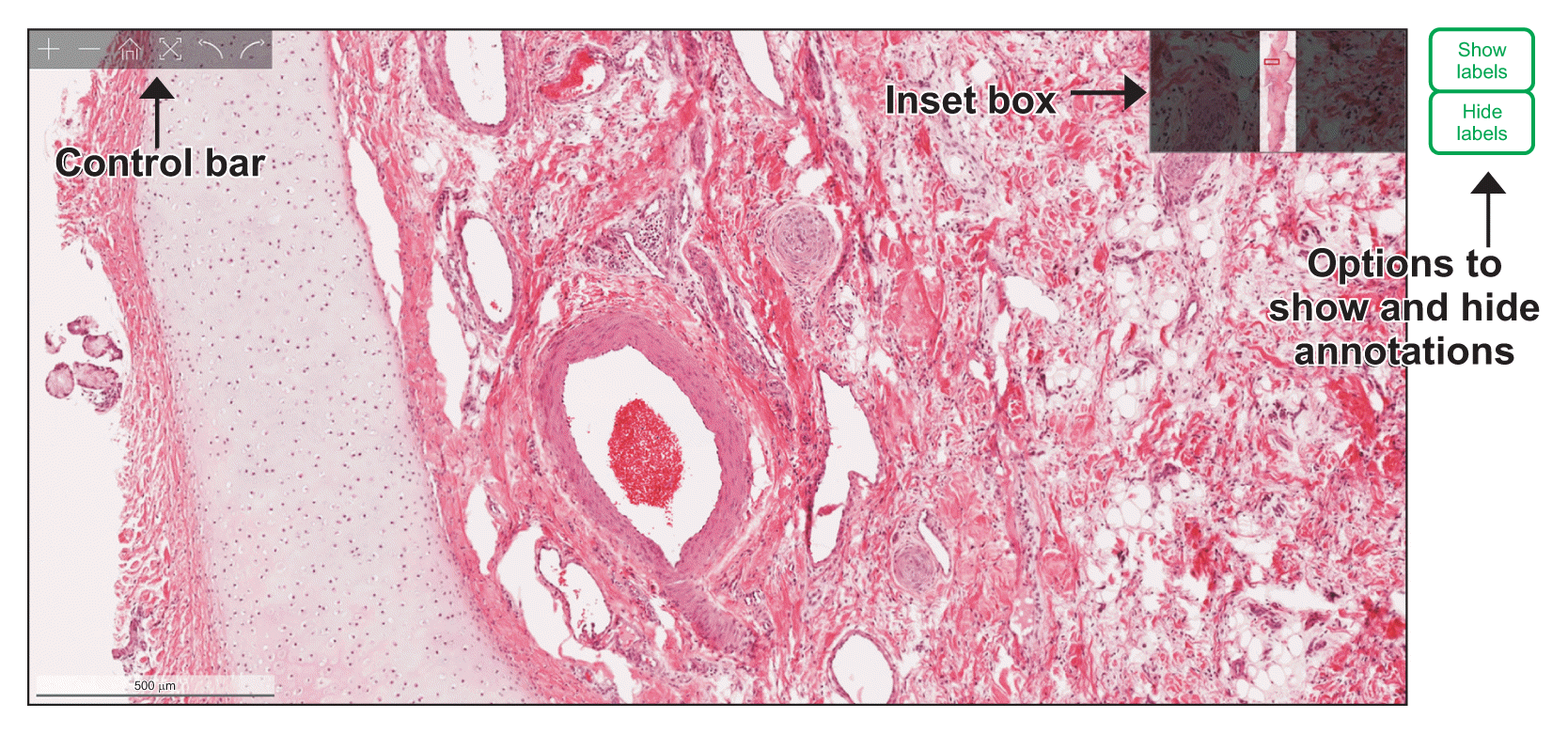|
Cross section of crown |
|
Cross section of tooth crown (incisor) |
20× |
0.497 |
17,987 × 13,230 |
|
Cross section of a tooth crown (premolar) |
20× |
0.497 |
35,975 × 28,613 |
|
Cross section of occlusal surface (molar) |
20× |
0.497 |
21,585 × 19,294 |
|
|
Cross section of root |
|
Cross section of root I |
40× |
0.247 |
37,800 × 21,881 |
|
Cross section of root II |
40× |
0.247 |
39,600 × 24,359 |
|
Cross section of root III |
40× |
0.247 |
50,399 × 28,112 |
|
Cross section of root, periodontal ligament, alveolar bone I |
40× |
0.247 |
54,000 × 49,764 |
|
Cross section of root, periodontal ligament, alveolar bone II |
40× |
0.247 |
52,199 × 33,395 |
|
Cross section of root, periodontal ligament, alveolar bone III |
40× |
0.247 |
50,399 × 39,356 |
|
|
Face development |
|
Cross section of embryo head (day 23) |
20× |
0.497 |
8,993 × 9,648 |
|
Cross section of embryo head (developing tongue, palate) I |
20× |
0.497 |
10,792 × 13,916 |
|
Cross section of embryo head (developing tongue, palate) II |
20× |
0.497 |
10,972 × 13,919 |
|
Cross section of embryo head (developing tongue, palate) III |
20× |
0.497 |
12,591 × 15,064 |
|
Cross section of embryo head (developing tongue, palate) IV |
20× |
0.497 |
10,792 × 15,729 |
|
Cross section of embryo head (face development) I |
20× |
0.497 |
21,585 × 13,619 |
|
Cross section of embryo head (face development) II |
20× |
0.497 |
21,585 × 13,045 |
|
|
Gingiva |
|
Longitudinal section of tooth, gingiva I |
20× |
0.497 |
55,762 × 28,349 |
|
Longitudinal section of tooth, gingiva II |
20× |
0.497 |
52,164 × 28,198 |
|
Longitudinal section of tooth, gingiva III |
20× |
0.497 |
57,561 × 25,626 |
|
|
Longitudinal tooth section |
|
Longitudinal ground section of tooth I |
20× |
0.497 |
34,176 × 15,701 |
|
Longitudinal ground section of tooth II |
20× |
0.497 |
41,372 × 19,779 |
|
Oblique section of tooth |
20× |
0.497 |
26,981 × 20,181 |
|
Longitudinal ground section of tooth III |
20× |
0.497 |
34,176 × 18,663 |
|
|
Pulp stone |
|
Tooth cross section with pulp stone I |
40× |
0.247 |
48,600 × 33,743 |
|
Tooth cross section with pulp stone II |
40× |
0.247 |
66,599 × 47,051 |
|
|
Palate |
|
Anterior palate I |
40× |
0.247 |
28,800 × 78,829 |
|
Anterior palate II |
40× |
0.247 |
28,800 × 78,830 |
|
Anterior palate III |
40× |
0.247 |
23,400 × 78,854 |
|
Anterior palate IV |
40× |
0.247 |
23,400 × 78,856 |
|
|
Parotid gland |
|
Cross section of parotid gland I |
20× |
0.497 |
34,176 × 17,838 |
|
Cross section of parotid gland II |
40× |
0.247 |
72,000 × 35,946 |
|
Cross section of parotid gland III |
40× |
0.247 |
75,600 × 29,470 |
|
Cross section of parotid gland IV |
40× |
0.247 |
63,000 × 27,881 |
|
Cross section of parotid gland V |
40× |
0.247 |
54,000 × 37,850 |
|
|
Periodontal ligament |
|
Cross section of root, periodontal ligament, alveolar bone I |
40× |
0.247 |
54,000 × 49,764 |
|
Cross section of root, periodontal ligament, alveolar bone II |
40× |
0.247 |
52,199 × 33,395 |
|
Cross section of root, periodontal ligament, alveolar bone III |
40× |
0.247 |
50,399 × 39,356 |
|
|
Sublingual gland |
|
Cross section of sublingual gland I |
40× |
0.247 |
59,399 × 50,399 |
|
Cross section of sublingual gland II |
40× |
0.247 |
52,199 × 50,928 |
|
Cross section of sublingual gland III |
40× |
0.247 |
52,199 × 51,262 |
|
|
Submandibular gland |
|
Cross section of submandibular gland I |
40× |
0.247 |
46,800 × 40,366 |
|
Cross section of submandibular gland II |
40× |
0.247 |
50,399 × 52,758 |
|
Cross section of submandibular gland III |
40× |
0.247 |
55,800 × 46,282 |
|
|
Temporomandibular joint (TMJ) |
|
Cross section of adult TMJ I |
20× |
0.497 |
39,573 × 38,056 |
|
Cross section of adult TMJ II |
20× |
0.497 |
41,372 × 40,021 |
|
Cross section of adult TMJ III |
20× |
0.497 |
46,768 × 37,196 |
|
Cross section of adult TMJ IV |
20× |
0.497 |
44,969 × 39,758 |
|
|
Tongue |
|
Cross section of tongue I |
20× |
0.497 |
23,384 × 28,673 |
|
Cross section of tongue II |
20× |
0.497 |
23,384 × 29,572 |
|
Cross section of tongue III |
20× |
0.497 |
26,981 × 25,530 |
|
Cross section of tongue IV |
20× |
0.497 |
25,183 × 21,910 |
|
Cross section of tongue V |
20× |
0.497 |
23,384 × 28,255 |
|
Cross section of tongue VI |
40× |
0.247 |
48,600 × 57,230 |
|
Cross section of tongue VII |
20× |
0.497 |
35,975 × 18,656 |
|
Cross section of tongue VIII |
20× |
0.497 |
34,167 × 16,192 |
|
Cross section of tongue IX |
20× |
0.497 |
34,167 × 22,859 |
|
|
Tooth development |
|
Developing tooth germ I |
20× |
0.497 |
19,786 × 28,606 |
|
Developing tooth germ II |
20× |
0.497 |
21,585 × 30,655 |
|
Bell stage of tooth development I |
20× |
0.497 |
21,585 × 42,668 |
|
Bell stage of tooth development II |
20× |
0.497 |
43,170 × 24,872 |
|
Bell stage of tooth development III |
20× |
0.497 |
23,384 × 39,290 |
|
Bell stage of tooth development IV |
20× |
0.497 |
26,981 × 44,779 |
|
Bell stage of tooth development V |
20× |
0.497 |
23,384 × 41,182 |
|
Bell stage of tooth development VI |
20× |
0.497 |
19,786 × 29,511 |
|
|
Tooth eruption |
|
Cross section of erupting tooth I |
20× |
0.497 |
26,981 × 27,831 |
|
Cross section of erupting tooth II |
20× |
0.497 |
30,579 × 26,829 |
|
Cross section of erupting tooth III |
20× |
0.497 |
30,579 × 24,025 |
|
Cross section of erupting tooth IV |
20× |
0.497 |
30,579 × 26,253 |
|
Cross section of erupting tooth V |
20× |
0.497 |
41,372 × 27,757 |
|
Cross section of erupting tooth VI |
20× |
0.497 |
41,372 × 27,758 |
|
Cross section of erupting tooth VII |
20× |
0.497 |
39,573 × 29,828 |
|
Cross section of erupting tooth VIII |
20× |
0.497 |
39,573 × 29,826 |
|
Cross section of erupting tooth IX |
20× |
0.497 |
37,774 × 21,687 |
|
Cross section of erupting tooth X |
20× |
0.497 |
35,975 × 22,846 |
|
Cross section of erupting tooth XI |
20× |
0.497 |
39,573 × 34,683 |
|
Cross section of erupting tooth XII |
20× |
0.497 |
41,372 × 32,695 |







 PDF
PDF Citation
Citation Print
Print



 XML Download
XML Download